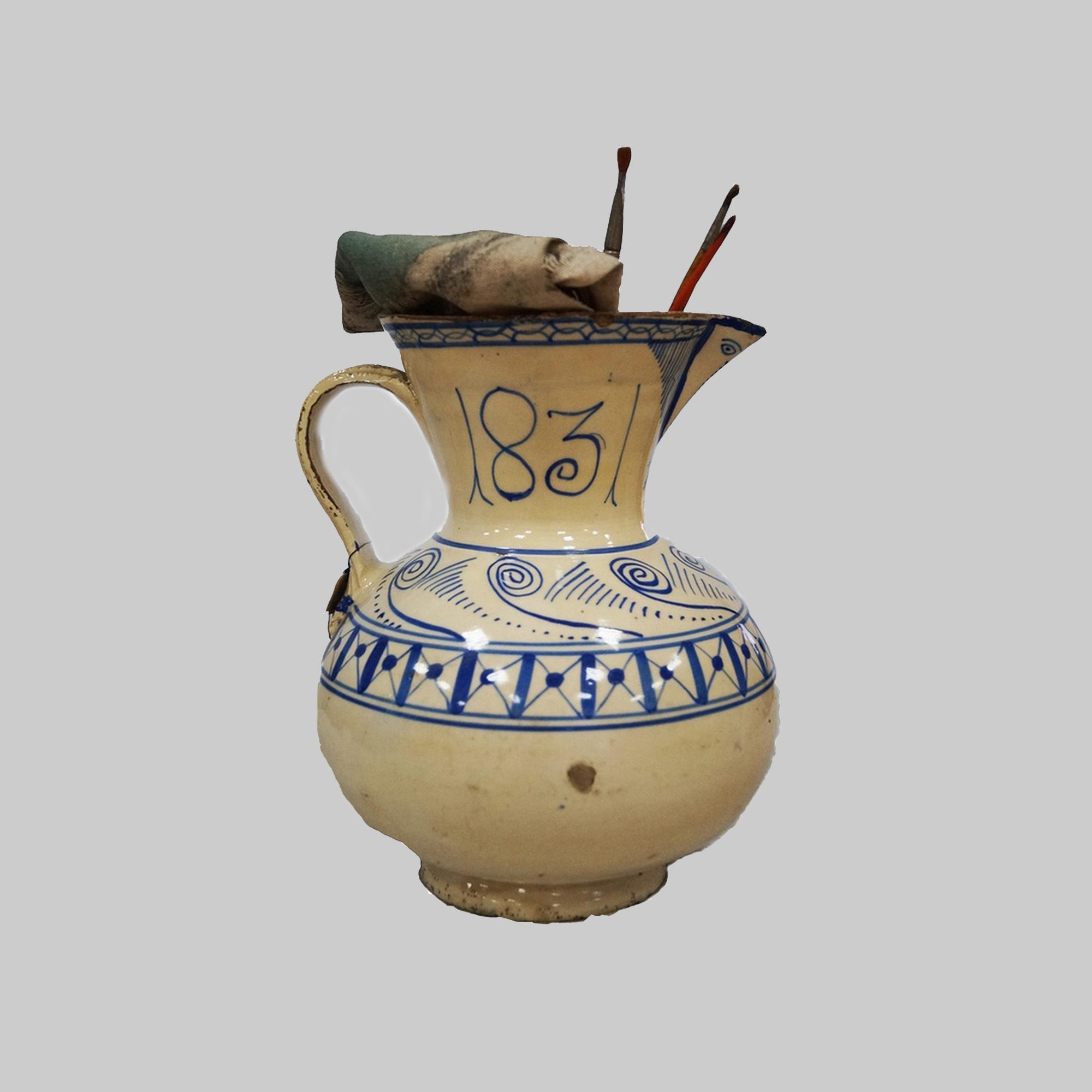The collection of the History and Art Museum of the city of Arzamas includes a clay jug with a majolica handle. It is decorated with Gzhel painting having a floral ornament and the date of manufacture — 1831.
#1
Village of Gzhel (unknown craftsman)
Jug
#2
#3
Majolica is a type of earthenware fired at a high temperature and decorated with colored glazes. This technique is used for making decorative panels, window trims, tiles, kitchenware, and sculpture.
Majolica production in Russia developed in the 18th century. The most popular centers producing such items were several local manufactories. Among them there was the factory of Afanasy Grebenshchikov in Moscow, which produced earthenware with monochrome painting; workshops in the village of Gzhel near Moscow where they mainly used polychrome painting at the time; and a major old majolica center in Yaroslavl where they produced glazed tiles for interior decoration of churches and houses.
A second wave of interest in majolica coincided with the Silver Age — the late 19th-early 20th century; it was linked to the famous colony of artists in the Abramtsevo Estate near Moscow that belonged to patron of the arts Savva Mamontov. Major Russian artists of that period worked with majolica: Mikhail Vrubel, Viktor Vasnetsov, Alexander Golovin, Sergey Malyutin, as well as foreign modernists: Fernand Léger, Pablo Picasso, and Maurits Escher.
Gzhel is a folk craft of making painted porcelain decorated with distinctive blue designs against the snow-white background. It takes its name from the village of Gzhel in the Moscow region, where they extracted one of the best types of clay in the country from the early 17th century. In 1663, Russian Tsar Aleksey Mikhailovich signed an order to extract clay for medical vessels in the Gzhel Region.
Pottery by Gzhel makers was very popular and that is why the range of manufactured products was very broad. It included tableware, bricks, tiles, and children’s toys that were supplied to Moscow. Gzhel ceramics reached its peak at the beginning of the 19th century. During that period, production of pitchers, Turkic and kvass jugs was marked by a high degree of professionalism. These items were covered with white glaze and then painted before firing. This jug by Alexander Stupin is one of such products.
Majolica production in Russia developed in the 18th century. The most popular centers producing such items were several local manufactories. Among them there was the factory of Afanasy Grebenshchikov in Moscow, which produced earthenware with monochrome painting; workshops in the village of Gzhel near Moscow where they mainly used polychrome painting at the time; and a major old majolica center in Yaroslavl where they produced glazed tiles for interior decoration of churches and houses.
A second wave of interest in majolica coincided with the Silver Age — the late 19th-early 20th century; it was linked to the famous colony of artists in the Abramtsevo Estate near Moscow that belonged to patron of the arts Savva Mamontov. Major Russian artists of that period worked with majolica: Mikhail Vrubel, Viktor Vasnetsov, Alexander Golovin, Sergey Malyutin, as well as foreign modernists: Fernand Léger, Pablo Picasso, and Maurits Escher.
Gzhel is a folk craft of making painted porcelain decorated with distinctive blue designs against the snow-white background. It takes its name from the village of Gzhel in the Moscow region, where they extracted one of the best types of clay in the country from the early 17th century. In 1663, Russian Tsar Aleksey Mikhailovich signed an order to extract clay for medical vessels in the Gzhel Region.
Pottery by Gzhel makers was very popular and that is why the range of manufactured products was very broad. It included tableware, bricks, tiles, and children’s toys that were supplied to Moscow. Gzhel ceramics reached its peak at the beginning of the 19th century. During that period, production of pitchers, Turkic and kvass jugs was marked by a high degree of professionalism. These items were covered with white glaze and then painted before firing. This jug by Alexander Stupin is one of such products.
#4
History and Art Museum of the city of Arzamas
читать дальшескрыть
00:00
00:00
1x
Jug
Время создания
1831
Размер
26.5х12х24 cm
Техника
ceramics, majolica
Выставка
4
Открыть в приложении
Поделиться



